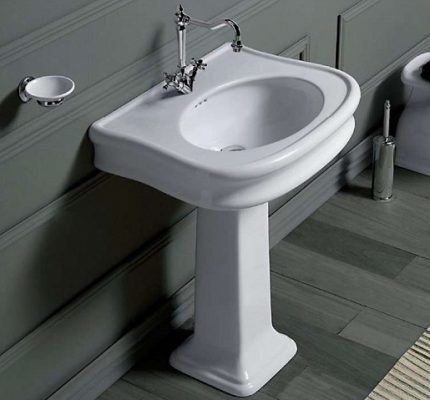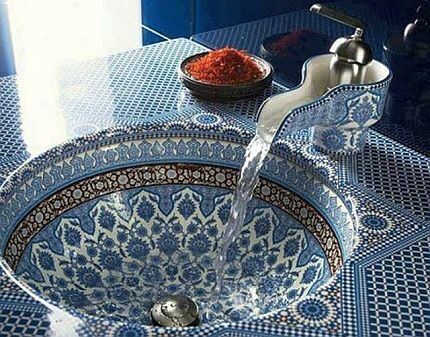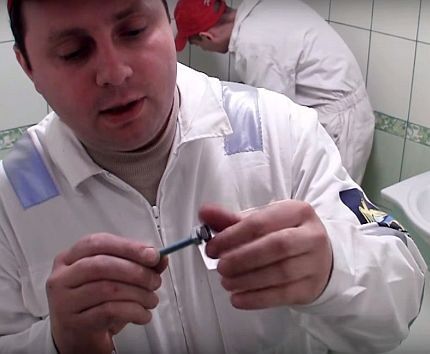Bathroom sink with pedestal: installation and connection technology
The aesthetics of a sink made in the shape of a tulip, the stability and practicality of this type of plumbing attracts many owners of city apartments and country houses. True, the cost of the device plus the price of assembly with connection cools it down somewhat. Do you agree? However, there is a way to reduce costs - do-it-yourself installation.
In the article we have presented, we consider the types of convenient and beautiful types of plumbing equipment. We will tell you how to install and fix a pedestal bathroom sink. For independent craftsmen, the technology for connecting a popular plumbing bowl with a support leg to communications is described in detail.
The content of the article:
Advantages of a pedestal sink
A type of shell with a pedestal or pedestal is also called a tulip due to the similarity of its appearance with the shape and beauty of the flower of the same name.
Despite the simplicity of the design, there are enough design options for this equipment to harmoniously fit into any modern interior.

For centuries, tulip shells have been popular among people due to the following positive properties:
- Versatility. A pedestal sink can be placed in any nook of the bathroom due to the variety of its shape, color and size.
- Compactness. The wall-mounted nature of the sink allows you to minimize the space occupied, and the space under the sink can be used for additional shelves.
- Aesthetics. The pedestal hides unsightly sewer and water pipes.
- Financial inclusion. The material of the sinks can vary in cost, but most of the assortment consists of budget sets.
- Easy to install. Most models are attached to the wall with two bolts, and the pedestal is not fixed with fasteners at all, remaining sandwiched between the sink and the floor.
Most of the disadvantages of pedestal sinks are due to their material of manufacture: earthenware and glass products are quite fragile and sensitive to shock, and metal and enameled ones can change color if poorly cared for.
Types of bathroom sinks and pedestals
Any sink is a bowl that can have several holes: for the bottom drain, for installing a faucet and for lateral drainage of excess water. Each manufacturer implements its own engineering solutions in its models, so there are no clear options for how to install a sink with a pedestal.
Classification by fastening method
Based on the fastening mechanism and decorative design of communications, five main types of sinks can be distinguished.
Mortise. This sink can be mounted into a stationary countertop in two ways:
- top;
- lower
With top mounting, only the neck of the sink fits into the countertop, and its main part is located above the countertop. When positioned at the bottom, the appearance of the sink is similar to a kitchen sink, in which only the fixing edge protrudes above the countertop.

Hanging (console). These sink bowls are attached directly to the wall with bolts or brackets. Their communications remain open from below or are subsequently hidden in under-sink cabinets.

Basins with pedestal. They differ from suspended ones by the presence of a special pedestal, which provides additional support and aesthetically hides all communications.

Semi-pedestal washbasins. The difference between a half-pedestal and a pedestal is that the former is short in length and does not reach the floor. The semi-pedestal is attached independently under the sink and serves only a decorative role to hide the pipes and siphon.

Furniture. Sinks of this type have an individual form of fastenings, which only fits the furniture that comes with them.

Most furniture sinks are expensive and are produced only by reputable brands.
How to choose a sanitary sink for installation in a bathroom by size is described in detail. in the article, which we recommend that you familiarize yourself with.
Types of shell materials
The cost of the products largely depends on the appearance of bathroom sinks and the material used to make them. You can buy a cheap enamel sink, but it certainly won’t add beauty to the bathroom.

The most common materials for modern sinks are:
- Faience. The cheapest and most unpretentious material from which most plumbing fixtures are made. Its disadvantage is a change in the color of the coating and the appearance of microcracks after several years of operation.
- Porcelain. Unlike earthenware, porcelain products undergo a two-stage burning process, therefore they have a snow-white coating, the color of which practically does not change over the years.
- Porcelain tiles or fake diamond. The advantage of this material is its strength, stable parameters of the external coating and ease of removal of coloring matter when it gets on the surface.
- A natural stone. This is an expensive fashion material, and it makes sense to install sinks in interiors made from natural materials. Its disadvantage is the presence of microcracks on the surface, which makes it almost impossible to remove the coloring substance that has reached the surface.
- Glass. Glass sinks can be made in any color. They are more expensive than earthenware, but cheaper than artificial stone. Water stains are very visible on the glass surface, so to maintain its beauty it is necessary to regularly wipe the surface with a cloth.
It is possible to manufacture sinks from steel, copper, plastic and other materials. Their shape can be round, square, angular or oval.
Dismantling old plumbing
When installing a new sink to replace old fixtures, it is important to know the steps to follow to remove the old fixtures.

When dismantling the old sink, work is carried out in the following sequence:
- The water is turned off and the tap valves are unscrewed.
- Removable if there is a pedestal.
- The faucet mount at the bottom of the sink is unscrewed and the tap is removed.
- The siphon is unscrewed from the neck of the sink and the water is carefully drained from it.
- The siphon pipe is pulled from the sewer hole, which is closed with a special stopper or plastic bag to block unpleasant odors.
- The nuts that secure the sink are unscrewed and it is removed.
When installing new plumbing, it is advisable not to use old flexible water hoses and a siphon, which may leak during re-installation due to worn rubber gaskets.
Installation of a pedestal sink
Once you've finished dismantling the old plumbing and cleaning the room, you can begin installing the new pedestal sink. Next, step-by-step instructions for this process will be discussed for a better understanding of the nuances of installation.
Regardless of the design and individual features of the model, installing a sink with a pedestal and connecting communications is carried out in the standard manner:
Step one: Determining the height of the sink. According to SNiP, the height of the upper edge of the sink above the floor should be 80-85 cm. But for tall people it can be increased to 90-95 cm, and if a separate sink for children is installed in a large bathroom, then the height can be reduced to 65-70 cm.
The specific level is decided at the family council, based on the wishes of each person. After the final choosing the height of the sink, a strictly horizontal line is drawn on the wall, which is checked using a building level.

Step two: fitting a sink. A pedestal is placed under the wall, on which a sink is placed on top.Its upper edge is aligned with the level drawn on the wall, after which at the bottom of the sink, with a marker, places for drilling mounting holes are marked. The equipment is then removed to the side.

Step three: installing rods for hanging a sink. Holes are drilled in the designated locations to a depth of at least 700 mm. The wall should be made of dense material and not crumble under the influence of a drill. Unstable partitions can cause the sink to fall and injure your feet.


Step four: re-fitting the sink. Similar to the second step, the equipment is tried on, taking into account the screwed-in fasteners. If the fasteners are positioned correctly and the horizontal level is maintained, then the sink and pedestal are set aside.

Step five: installing a siphon and mixer on the sink. In order not to suffer from a lack of space when installing a faucet and siphon on already installed plumbing, it is easier to do this before attaching the sink bowl to the wall.
Each plumbing product is accompanied by a diagram and sequence of its installation, therefore screwing the sewer siphon and the tap should not cause any difficulties.There is no need to lubricate the joints on the sink openings with sealant; rubber gaskets should be sufficient for sealing in these places.
Connection to the sewer and installation of the siphon is carried out in the following order:
Step six: sink installation and connection of communications. The sink with equipped siphon and tap is hung on mounting bolts. Between the bowl and the wall, as well as in front of the fixing nut, special soft gaskets are placed on the rods. They prevent chipping of the ceramic coating when tightening the fasteners.
The nuts are lightly tightened by hand, after which they begin connecting the hoses to the water pipes and sewerage. After connecting the communications, a test opening of the water is carried out.

Step seven: installation of a pedestal. If there are no leaks in the system, then you can place a pedestal under a hanging sink. The final tightening of the fixing nuts must be done after aligning the edge of the sink with the horizontal line drawn on the wall.
The plumbing is ready for use. For decoration, you can cover the seam between the sink and the wall with white sealant.
Features of installing a half-pedestal
If a semi-pedestal is chosen as the equipment covering the sink communications, then you need to know about the differences in its installation from the installation of a classic “tulip”.

The first six steps discussed above for attaching the sink to the wall and connecting communications remain unchanged.
Further actions must be carried out in the following sequence:
- Since the semi-pedestal has its own fastenings, then after sink installation It is necessary to try the product on the wall and mark the locations for drilling holes for bolts.
- Drill the wall with a drill and insert dowels into the holes.
- Place the half-pedestal and screw it to the wall with bolts, placing rubber spacers between the product and the wall, as well as in front of the fixing nut.
The weight of the sink is not transferred to the semi-pedestal, so there is no need to try harder to screw it to the wall.
Conclusions and useful video on the topic
Video stories allow you to better connect in your head the parts of the whole presented in the form of printed text. Therefore, the videos below help create a general vision of the process of installing a sink on various pedestal options.
Video #1. Installing a sink on a pedestal with an additional box:
Video #2. Sink installation:
Video #3. Installation of a sink on a cabinet:
The described methods for installing a sink and pedestal, as well as the nuances of their installation, will allow you to complete this work yourself. The main thing is to choose the right equipment and connecting parts for it, and the rest can be easily done using the suggested techniques and simple home tools.
Please write comments in the block below. Ask questions, post useful information and photographs on the topic of the article. Or maybe you want to share your personal experience in installing a pedestal sink?




In our small old apartment, we had a sink with a cabinet in our bathroom. And when we moved into our private home, we had a large hotel bathroom, in it there was space for a sink with a pedestal and a separate cabinet for all the accessories that had previously been in the cabinet under the sink. Of course, with a pedestal the view is much more beautiful, only this option is suitable for a large area.
Be sure to check the sink in the store for cracks and chips. Make sure that it itself is symmetrical and that the mounting holes on it are made with high quality, without nicks. The installation itself, although not too complicated, can be inconvenient for a beginner. But such sinks look beautiful and original, especially designer ones. It's always nice to see something different from the standard.
In principle, there is nothing difficult about installing such a sink yourself. It is enough to have the necessary tools and direct hands. If any of this is missing, it is better to contact professional installers. They have the tools, but they don’t always have straight hands. That's why I do everything myself. If I messed up myself, I fixed it myself. And there is no one to complain to - beauty.